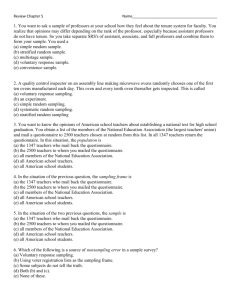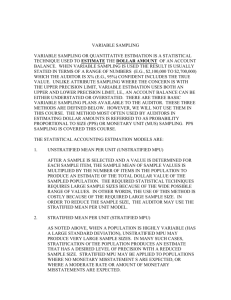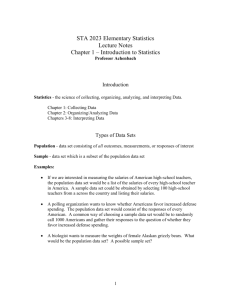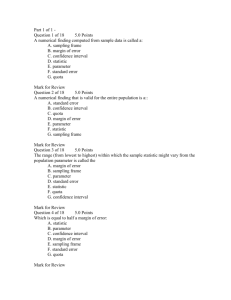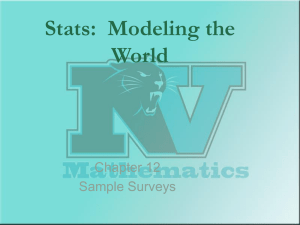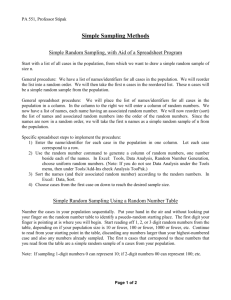PowerPoint Slides that accompany the lecture
advertisement
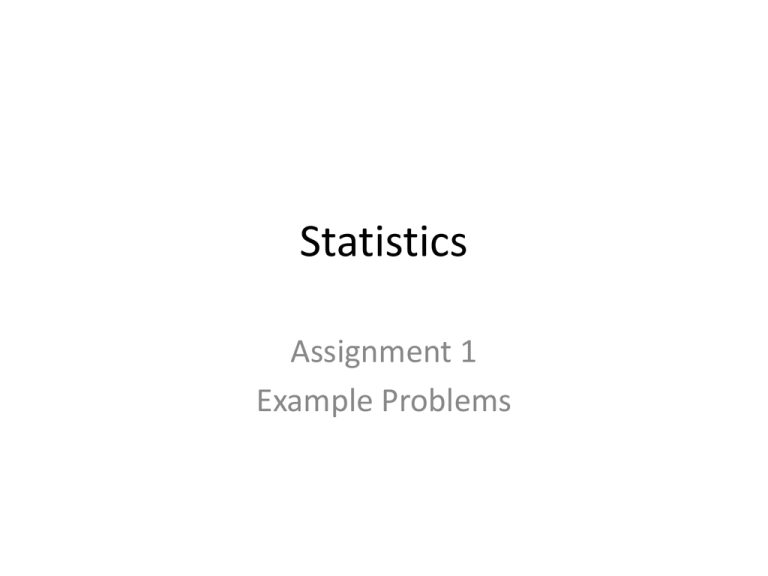
Statistics Assignment 1 Example Problems Types of Data • Question: Determine whether the given value is a statistic or a parameter. – In a study of all 1904 seniors at college, it is found that 25% own a television. • Answer: Know your definitions! – A statistic is a numerical measurement describing some characteristic of a sample – A parameter is a numerical measurement describing some characteristic of a population Types of Data • Question: Determine whether the given value is a statistic or a parameter. – In a study of all 1904 seniors at college, it is found that 25% own a television. • Answer: A parameter is a numerical measurement describing some characteristic of a population Types of Data • Question: Determine whether the value given below is from a discrete or continuous data set. – The volume of cola in a can is 10.4 oz. • Answer: Know your definitions! – Discrete data result when the number of possible values is either a finite number or a “countable” number (e.g. 0, 1, 2, …) – Continuous data result from infinitely many possible values that correspond to some continuous scale that covers a range of values without gaps, interruptions, or jumps. Types of Data • Question: Determine whether the value given below is from a discrete or continuous data set. – The volume of cola in a can is 10.4 oz. • Answer: Continuous data result from infinitely many possible values that correspond to some continuous scale that covers a range of values without gaps, interruptions, or jumps. Types of Data • Objective: Identify sample and population; determine whether a sample is a representative of a population • Question: – Some people responded to this request: “Dial 1-900PRO-LIFE to participate in a telephone poll on abortion. ($4.95 per minute. Average call: 3 minutes. You must be 17 years old.)” – Identify the sample and population as well as determine whether the sample is likely to be representative of the population Types of Data • Question: – Some people responded to this request: “Dial 1900-PRO-LIFE to participate in a telephone poll on abortion. ($4.95 per minute. Average call: 3 minutes. You must be 17 years old.)” • Answer: The sample would be all the individuals that actually responded. Types of Data • Question: – Some people responded to this request: “Dial 1900-PRO-LIFE to participate in a telephone poll on abortion. ($4.95 per minute. Average call: 3 minutes. You must be 17 years old.)” • Answer: The population would be all individuals who are at least 17 years of age. Types of Data • Question: – Some people responded to this request: “Dial 1900-PRO-LIFE to participate in a telephone poll on abortion. ($4.95 per minute. Average call: 3 minutes. You must be 17 years old.)” • Answer: No, the sample is not likely to be representative of the population because those with strong opinions about abortion are more likely to respond. Collecting Sample Data • Objective: Identify types of sampling used. • Question: Identify which type of sampling is used: random, systematic, convenience, stratified, or cluster. – To determine her heart rate, Britney divides up her day into three parts: morning, afternoon, and evening. She then measures her heart rate at 4 randomly selected times during each part of the day. – Which type of sampling is used? Collecting Sample Data • To determine her heart rate, Britney divides up her day into three parts: morning, afternoon, and evening. She then measures her heart rate at 4 randomly selected times during each part of the day. Which type of sampling is used? • Answer: Well I know I can rule out Random (equal chance of being selected), Convenience (easy to obtain) and Systematic (every kth element) because she “divides up her day into parts”. So the question is “Is this Stratified or Cluster”? – Remember that Stratified sampling the subgroups have the same characteristics. Cluster sampling the subgroups are just “divided”. What is common is doing the same thing in each sub group (measuring heart rate), and thus would be Stratified.


